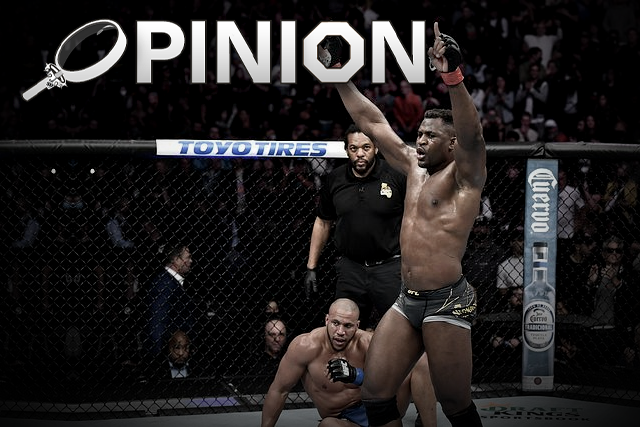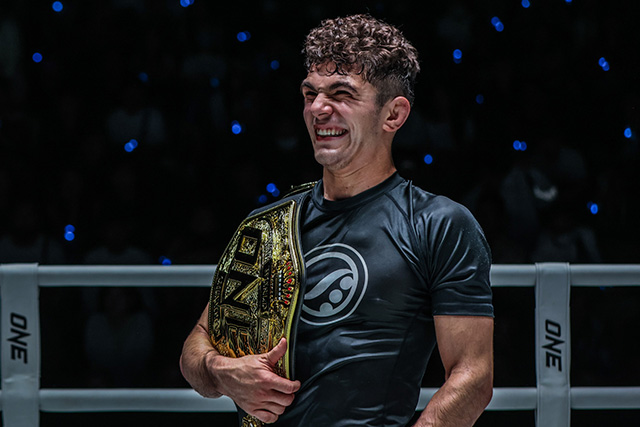The Rise of MMA Professionalism and its Consequences

John
Brannigan/Sherdog.com illustration
Sign up for ESPN+ right here, and you can then stream the UFC live on your smart TV, computer, phone, tablet or streaming device via the ESPN app.
Advertisement
That's surprising enough in and of itself, especially given the violent endings expected of Francis Ngannou-Ciryl Gane, Giga Chikadze-Calvin Kattar, Sean Strickland-Jack Hermansson and Israel Adesanya-Robert Whittaker 2, but what's even more notable is the nature of the decisions. While two of the decisions, Chikadze vs. Kattar and Strickland vs. Hermansson, were clear-cut, the other five were very close. Most observers believe that Ngannou, Figueiredo and Bellator 274 headliner Logan Storley triumphed by a single round, and it's an open debate whether the right man was given the title in either Adesanya-Whittaker 2 or Ryan Bader-Valentin Moldavsky. Is this trend of closely contested decisions just a blip, a consequence of a small sample size?
While I believe we will see plenty of finishes in main events and
championship fights later in the year, this is a signal of a new
trend. Main events going to decision, and close ones at that, will
become an increasingly common occurrence. There are two reasons for
this. One is that top fighters are becoming more skilled. The other
that they are coached better and fighting smarter. Together, those
factors combine for what I call a rise in MMA professionalism.
To start, elite fighters now are ridiculously skilled compared to even five years ago. In the past, even great champions had areas of significant weakness that could be exploited. Wanderlei Silva and Chuck Liddell had severe defensive deficiencies and both could be taken down by skilled enough wrestlers. Anderson Silva could be taken down and ground-and-pounded and wasn't especially good at getting back up. Fedor Emelianenko was great at getting up, but was very vulnerable to ground-and-pound if kept down, and would miss the occasional big punch on the feet. Georges St. Pierre had a relative weakness in the standup, offensively as well as defensively, even being badly hurt or knocked out by those who wouldn't be considered especially good strikers nowadays like B.J. Penn or Matt Serra, which is one reason he grew to rely so much on his wrestling. This isn't to demean any of these legends, but simply to note how much MMA skill has evolved.
By contrast, what major weakness does someone like Israel Adesanya present — especially one significant enough for an opponent to incapacitate him in 25 minutes or less? He is incredibly difficult to take down, even for excellent wrestlers like Derek Brunson and Marvin Vettori, and even if one succeeds, he usually pops right back up instantly. Even very late in a fight, working from his back against a much heavier opponent like Jan Blachowicz, Adesanya is plenty competent. In the striking, it's possible to disrupt his offensive flow and reads, as we've seen, but to actually finish him?
Adesanya is far from unbeatable, as Whittaker arguably managed the feat at UFC 271 and I had Yoel Romero beating him three rounds to two at UFC 248, as did most observers, but imagining anyone his own size dominating or even finishing him? That's very difficult to envision.
Same with someone like Ngannou. His wrestling is very solid now, he gets up amazingly well in the rare instances he is taken down, manages his cardio well, has an iron chin, and is arguably the most dangerous offensive striker in the world. Again, a very skilled challenger can cautiously outpoint him, as Gane did for the first two rounds, but as for badly beating or stopping him? He is just too good for that.
This even applies to both participants in Bader-Moldavsky. Moldavsky might not have especially threatening striking, but where is he weak? He's an extraordinarily well-rounded fighter. How does one beat him decisively? As for Bader, yes, he has a poor chin, but it's sturdier at heavyweight without the cut, and it still takes a very talented, fast striker to take advantage of it, especially since his defensive technique is quite good.
However, this is only half the puzzle. The other is how intelligently top martial artists fight now. They are very calm, watch a ton of tape, and come up with excellent game plans and adjustments working with their coaches, who are also becoming smarter every year. Hell, I wrote an article talking about a new approach to striking that Adesanya and Gane have largely pioneered. As I noted in that article, this style is beatable, but not only is that challenging, but the whole point of their approach is to take very few risks. Which in turn makes it exceedingly unlikely that anyone will knock them out in 25 minutes or less, never mind that both men have iron chins and wonderful recuperative powers.
Furthermore, fighters at that level have already established themselves, so they cannot afford not to engage in the kind of risky, toe-to-toe battles that UFC President Dana White would prefer. While unranked, fledgling mixed martial artists can be cut or not re-signed if they grapple too much or prioritize safety, that's not the case for championship or even main event-level prizefighters.
Ngannou’s victory over Gane, one of the most satisfying outcomes for me in the past few years, was a prime example of all these elements. Not only did he infuriate Dana White, who desperately wanted him to lose, while also fighting in a style the former boxercise coach absolutely despises, but he proved that he isn't simply a menacing knockout artist, but a true martial artist of the highest intelligence, discipline and skill. And so are a number of other elite fighters nowadays.
What are the consequences of this MMA professionalism? We will see a large increase in close decisions for main events and other high-level match-ups. That in turn means cageside judges will have a greater influence on the results of elite MMA, and by extension, championships and the overall history of the sport. Considering their well-covered bias and incompetence, that's an unsettling, negative development. Aesthetically, it may also turn off many fans, who want to see vicious, violent endings, not an announcer reading scorecards where the victor is unclear.
On the bright side, it can make for some tremendous, cerebral battles. The first and third meetings between Figueiredo and Moreno were both all-time classics despite being a draw and narrow decision victory for the Brazilian, and I've written before about how Kamaru Usman-Colby Covington 2 might be my favorite fight ever. Undoubtedly though, this rise in MMA professionalism is a trend that will permanently change the sport.
« Previous Rivalries: Misha Cirkunov
Next Manager Believes Alex Pereira-Israel Adesanaya Fight Could Happen Sooner Than Expected »
More




 UFC News & Features
UFC News & Features